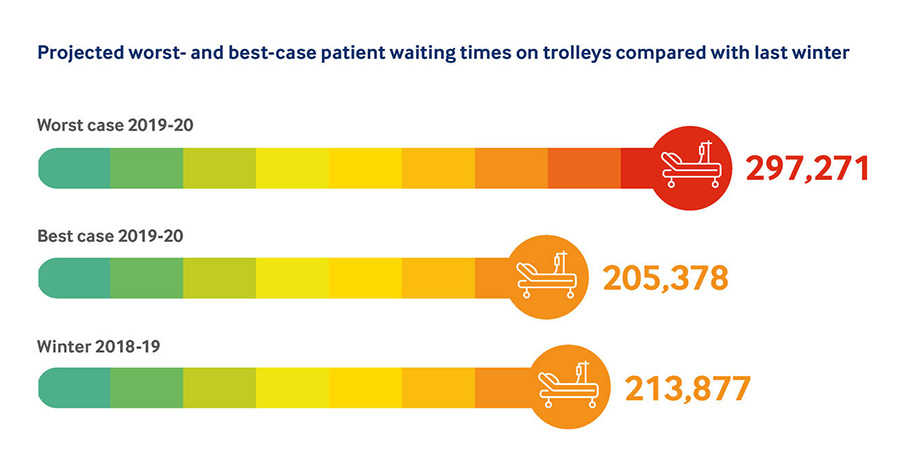Routine publication of the first Combined Performance and SitRep data that will show the gathering winter crisis in the NHS has been deftly postponed by NHS England to the DAY AFTER the election.
The statistics would normally be published on the second Thursday of the month – in this case polling day December 12. NHS England Statistics has now confirmed that the figures will appear on December 13.
This will be a considerable relief to the Johnson government, whose ministers would not have relished having to fend off critical questions on news media on the day voters will be making up their minds which party to support.
It’s already clear that this winter is set to be yet another worst-ever for the NHS: the first hospitals have already begun declaring “black alerts” – now known as Opel 4 – in early November, and the winter’s first “critical incident” was declared by Nottingham University Hospitals Trust – which has been exempt from normal reporting on its A&E performance since April because it is a pilot site trialling new targets.
All these indicators – along with the widespread record levels of bed occupancy and pressure on emergency services right through the previously relatively quiet summer months – are signs of impending crisis, and indicators that the numbers of beds and staff are insufficient.
Even before the first signs of winter the Nottingham trust’s Integrated Performance report was a sea of red ink for missed targets for reducing delayed ambulance handovers, for patients marooned in beds for more than 3 weeks, for cancelled operations and for swift access to cancer treatment.
Trust finance directors are trying to wrestle down a projected deficit of £45m this year to £27m to qualify for a handout from the Financial Recovery Fund.
But the trust’s finances are already propped up by £97m of borrowing, and the trust’s buildings are saddled with a £130m backlog bill for maintenance.
The Health Service Journal notes that NUH also reported black alerts over the summer – “unusual for hospitals outside areas attracting high numbers of tourists” – and to make matters worse its urgent and emergency services were rated “requires improvement” by the Care Quality Commission in March.
Spread of ‘Black alerts’
Early November has also seen black alerts at Queen Elizabeth and Lewisham Hospitals in SE London, both of which were full to capacity – but managed to avoid turning patients away, partly through the efforts of social care staff assisting to move some adult patients out of hospital more quickly.
In Lincolnshire, where the United Lincolnshire Hospitals Trust is in its third year of special measures, the A&E is under pressure and management seeking measures including cancellation of non-urgent operations to free up beds.
Birmingham, too, is being warned to brace for a waiting times “nightmare” this winter, on the basis of analysis by the local newspaper’s Reach Data Unit, which forecasts that in this one city hospitals could leave as many as 77,000 people waiting in A&E between January and March, with as few as 57.6% seen in the 4 hour target time.
Even in September only 64% of patients attending major A&Es in University Hospitals Birmingham Trust waited less than 4 hours, and the neighbouring Sandwell and West Birmingham trust was only slightly better at 67%.
BMA report
The Reach Data Unit applied the same methodology as a recent BMA report The NHS and a perfect storm of winter pressures, which warns that England’s health service, trusts and GP practices are almost certain to endure “the most pressurised winter on record”:
“Lack of recovery from summer, combined with other factors such as pensions taxation legislation forcing senior doctors to work fewer shifts to avoid large tax bills, and energy being spent on Brexit planning rather than winter preparedness, means the NHS is facing a ‘perfect storm’ this winter”
This last summer was worse than the BMA had expected, with actual performance worse than the worst case on A&E waiting times and trolley waits, with 179,000 waiting over 4 hours for a bed after a decision to admit.
The new report anticipates further increases in admissions and trolley waits, and warns “the winter could be substantially worse than our worst-case projections, especially if other factors – such as particularly cold weather and significant flu outbreaks – occur this year.”
Perhaps most telling of all as voters are bombarded with professions of love for the NHS by government ministers is the lack of any additional funding to help services cope this winter:
“At the time of writing, the Government has not made any additional winter funding available to the NHS and social care to mitigate winter pressures, and with Parliament dissolved, there is now no mechanism to do so.
“In recent years, funding in the region of two to three hundred million pounds has been announced ahead of the winter months, but this year the NHS will receive nothing.”
Dear Reader,
If you like our content please support our campaigning journalism to protect health care for all.
Our goal is to inform people, hold our politicians to account and help to build change through evidence based ideas.
Everyone should have access to comprehensive healthcare, but our NHS needs support. You can help us to continue to counter bad policy, battle neglect of the NHS and correct dangerous mis-infomation.
Supporters of the NHS are crucial in sustaining our health service and with your help we will be able to engage more people in securing its future.
Please donate to help support our campaigning NHS research and journalism.


